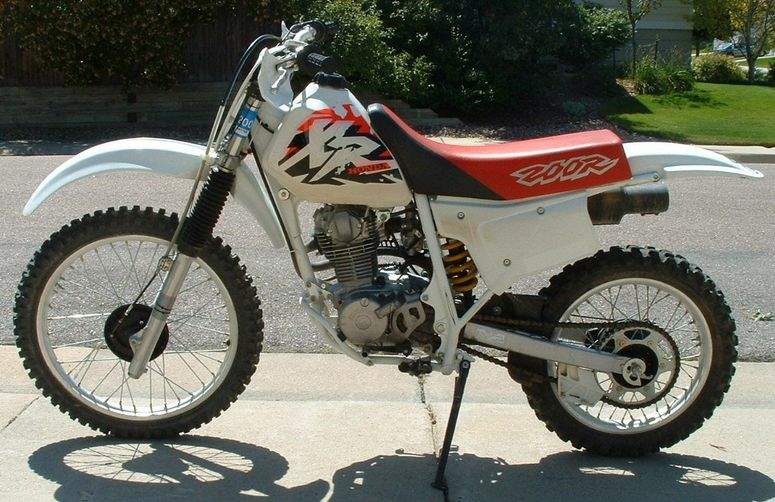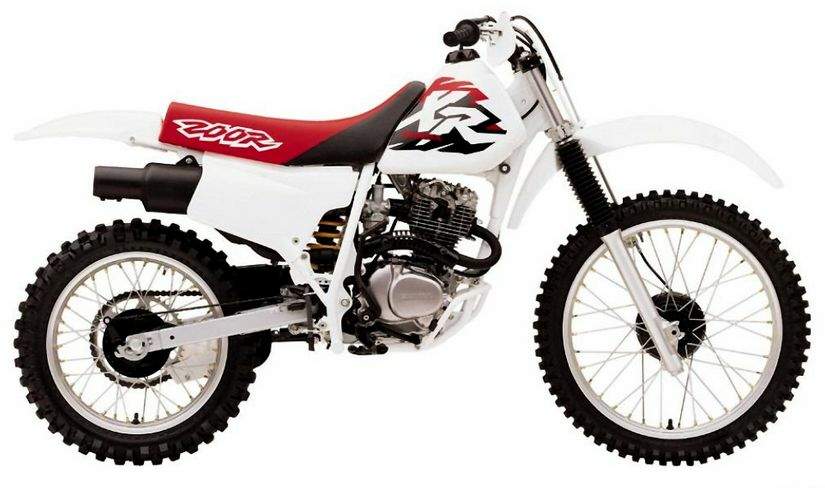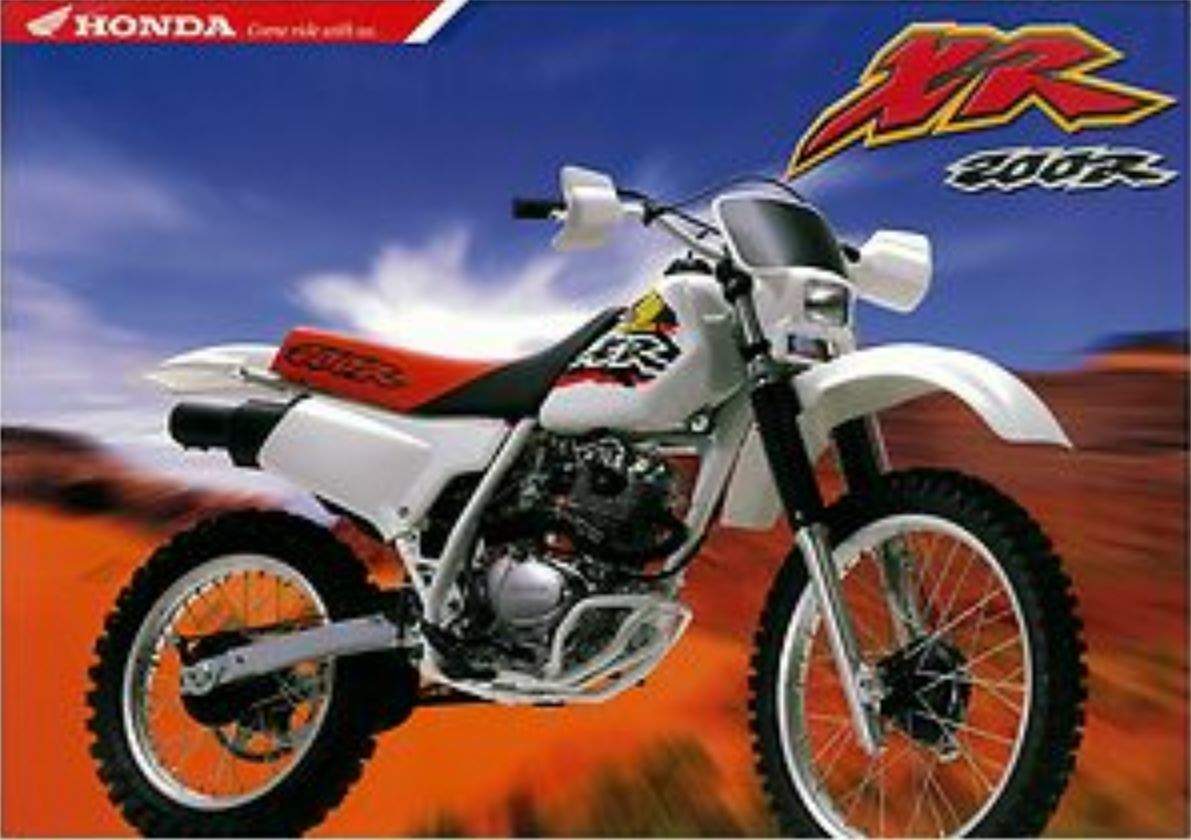
|
|
|
|
|
|
Classic Bikes
Custom Bikes
Individual
Racing Bikes AJP
AJS
Aprilia
Ariel
Avinton / Wakan
Bajaj
Benelli
Beta
Bimota
BMW
Brough Superior
BRP Cam-Am
BSA
Buell / EBR
Bultaco
Cagiva
Campagna
CCM
CF Moto
Combat Motors
Derbi
Deus
Ducati
Excelsior
GASGAS
Ghezzi Brian
Gilera
GIMA
Harley Davidson
Hero
Highland
Honda
Horex
Husaberg
Husqvarna
Hyosung
Indian
Jawa
Kawasaki
KTM
KYMCO
Laverda
Lazareth
Magni
Maico
Mash
Matchless
Mondial
Moto Guzzi
Moto Morini
MV Agusta
MZ / MuZ
NCR
Norton
NSU
Paton
Peugeot
Piaggio
Revival Cycles
Roland Sands
Royal Enfield
Sachs
Sherco
Sunbeam
Suzuki
SWM
SYM
Triumph
TVS
Ural
Velocette
Vespa
Victory
Vincent
VOR
Voxan
Vyrus
Walt Siegl
Walz
Wrenchmonkees
Wunderlich
XTR / Radical
Yamaha
Zero
Video
Technical
Complete Manufacturer List
|
Honda XR 200R
|
| . |
|
Make Model |
Honda XR 200R |
|
Year |
1997 - 98 |
|
Engine |
Four stroke, single cylinder SOHC, 2 valve, chain driven overhead camshaft |
|
Capacity |
195 cc / 11.8 cu-in |
| Bore x Stroke | 67 x 56.5 mm |
| Compression Ratio | 10.0:1 |
| Lubrication | Forced pressure and wet sump |
|
Induction |
2x 20 mm piston valve Keihin carburator |
|
Ignition |
Solid state CD |
| Spark Plug | NGK DR8ES-L |
| Starting | Kick |
|
Max Power |
23 hp / 17.1 Kw @ 9000 rpm |
|
Max Torque |
19.5 Nm / 14.4 lb-ft @ 7500 rpm |
| Clutch | Wet multiplate type |
|
Transmission |
6 Speed |
| Final Drive | Chain |
| Primary Reduction | 3.316 |
| Gear Ratio | 1st 2.769:1 2nd 1.941:1 3rd 1.450:1 4th 1.130:1 5th 0.923:1 6th 0.785:1 |
| Frame | Semi double cradle |
|
Front Suspension |
36 mm Air-adjustable forks with dual Syntallic bushings |
| Front Wheel Travel | 254 mm / 10.0 in |
|
Rear Suspension |
Pro-Link, single Showa shock, adjustable |
| Rear Wheel Travel | 246 mm / 9.7 in |
|
Front Brakes |
Drum, swept area - 86.3 cm2 / 13.3 sq. in. |
|
Rear Brakes |
Drum, swept area - 86.3 cm2 / 13.3 sq. in |
|
Front Tyre |
3.00/21(6PR) |
|
Rear Tyre |
110/90/17(6PR) |
| Rake | 26° |
| Trail | 105 mm / 4.1 in |
| Dimensions |
Length 2035mm / 80.1 in Width 865mm / 34.1 in Height 1180mm / 46.5 in |
| Wheelbase | 1365 mm / 53.7 in |
| Seat Height | 850mm / 33.5 in |
| Dry Weight | 102 kg / 224.8 lbs |
|
Wet-Weight |
109 kg / 240 lbs |
| Ground Clearance | 315 mm / 12.4 in |
|
Fuel Capacity |
9.0 Litres / 2.4 gal |
| . |
Is the Honda XR200 a race bike? No, but it is a reliable, torquey, lightweight, easy to ride, and simple trail bike that is great for tight and technical riding. It may not be the best at anything in stock form, but it does a lot of things very well in the off-road scene, and let me tell you, it is a BLAST to ride! The XR200R started out with decent suspension back in the 80s that was adjustable and fully rebuildable, but went downhill in the 90s until Honda stopped importing the bike to the U.S. in 2002.
The XR200R was featured as the Used Dirt Bike of the Month in July of 2013 here on Motocross Hideout. It briefly goes over the pros and cons of this bike, but now we will go over some real mods and tricks to make your current or future XR200 rig a force to be reckoned with.
It’s hard to find used ones in good shape, but with some TLC, along with a little bit of money thrown at it, you can be spinning laps through the woods in no time!
First thing to look at is the suspension. If you weigh over 150 pounds and are aggressive at all, the stock suspension on any year XR200 is under-sprung, as well as under-damped. 1981-83 had single adjustable shocks and 1984-1991 were fully adjustable. After that, Honda stuck on a cheap, non-rebuildable and non-adjustable rear shock, along with shorter forks. Both combine for a lower seat height and an even lower performing trail bike. While it may have the same power-plant throughout the years (except for the ’84/85 RFVC 4-valve engine), many people base the XR200’s capabilities off of the ’92 to ’02 because there are more of them to be had on the used market.

The stock shock on an ’84-’91 (84-85 XR250 shocks are the same and will bolt on) are surprisingly good, and much better than the non-adjustable shocks on any of newer XR200’s after being rebuilt. They’re not too hard to find on eBay, but a lot of them are in rough shape. You will want to service it at the least. A new head seal kit is a good idea, and if you really want it to perform better you can send it out to get re-valve for your weight and riding style. This is the best bang for your buck, but if you want the highest performance, a Works shock will cost you a hefty 500 American buckaroos, give or take. While it’s a great upgrade compared to the 92-02 stock pogo-stick shock, it may not be worth it if you’re on a budget and don’t need a full-on race machine.
Much like the shock, the forks were downgraded on the Honda XR200R after 1991. They were not adjustable, and they lost some much needed suspension travel; thus lowering the seat height. This was done to make it more of a ‘beginner bike’. It’s not difficult to swap out the internals to bring the travel back up, but it’s just one more thing to do. The best forks from an XR200 are on the 1986-1991 models, and they can bolt right on to the later model 200’s. However, this isn’t the only option you have (more on this shortly).
If you get the early model XR200 forks, you can get stiffer progressive springs that can handle heavier and more aggressive riders and are fairly inexpensive. Servicing the forks and putting some heavier weight fork oil can help slow the damping down, which is probably the weakest point of any stock XR suspension component.
If you want to spend a little more time and money, you can swap out the stock forks from with a set from another bike that has better/bigger forks. 1984-85 Honda XR250R forks are bigger, but they require the complete front-end to fit on an XR200. If you go this route, you will also get a much needed front disk brake upgrade. They only have 10 inches of travel (same as the early XR200), but the internals are beefier so it can take more abuse.
A step up from that would be the forks from a 1986-1995 XR250R. They have 11 inches of travel and are 41mm in diameter, compared to the stock 36mm on the 200R. They have a disk brake as well and will require the complete front-end to work on the XR200. If you do this swap, the front end will be higher, causing a difference in bike geometry and the handling with change. To combat this you can pull the forks up in the triple clamps, or change the rear-end height with a different shock/linkage that will raise it up to level the bike back out.
Another common swap, and probably the best bang for the buck if you can find a cheap roller, is swapping a front-end off of a late 80s Honda CR125/250R motocross bike. They aren’t inverted forks like modern MX bikes, but they are cartridge forks that perform a lot better than the stock conventional damper-rod forks. They also have disk brakes that are leaps and bounds better than the XR brakes. These aren’t technically a ‘bolt-on’ swap, but a specific height for a spacer is the only major part you will need to ‘fabricate’. These forks will definitely raise the height of the front-end, so you’ll want to move the forks up and/or compensate with the rear suspension or else the handling will suffer.

I could go on for quite some time about suspension mods for this bike, but I’ll let you decide and continue the research if needed. I wanted to cover suspension mods first because “go-fast” mods won’t help much when you’re bottoming out on braking bumps with a stock suspended XR200. The intake, as well as the exhaust, are rather choked up on almost every Honda XR from the factory. You may not want to do every single modification depending on your riding conditions because some of the OEM parts are designed to protect the bike from possible failure.
The airbox helps keep the air filter clean from dirt and water, but there’s very few openings for air to get to the filter. By “opening it up”, it will allow more air to flow through the carburetor, resulting in a noticeable increase in throttle response and power. To do this, the best way is to remove the snorkel on top of the airbox. Just remove the top cap part and keep the other piece that has the three ducts/openings. More water can get in if you ride through mudholes, but it’s still protected because you’re just opening the airbox on the top.
Another intake mod is replacing the stock filter with a bigger and more free-flowing air filter. This will let that new air actually reach the carburetor and use it to make a little more power. If everything else is stock, you shouldn’t have to re-jet the carb because the XR200 comes rich from the factory.
This is another modification that may require some compromise. If you need your XR200 to stay quiet because of neighbors or rules/regulations, you probably won’t find anything quieter than the stock exhaust. You can pull the baffle out for a good improvement in throttle response and low-end torque. However, it will be considerably louder. The stock head pipe also restricts the bike, so replacing it with a larger diameter aftermarket pipe will yield noticeable horsepower gains throughout the RPM range. XRs Only sells a stainless pipe that is meant to go along with their silencer. I have not personally tested this head pipe with the stock muffler, so I do not know if it will bolt on due to the larger diameter (however, this is on my to-do list and I report back when I find out for sure).
You can look for a supertrapp exhaust, but the consensus is that this is quite a bit louder than stock as well. If you want to be stealth, then the complete stock muffler is the best choice. On the other hand, a number of XR200 owners have swapped out the baffle that is held in with the bottom two bolts for the stock baffle from an early to mid 80’s Honda ATC 250R. It is not much louder while giving you back the performance similar to running it without a baffle due to it flowing better.

If the engine starts and runs strong without smoking, it’s probably the last thing I’d look at as far as mods. Why? Because it’s the most expensive, and the other mods should be done first to “un-cork” it. If you really want to add some torque and horsepower, there’s still some room for improvement in the cylinder and head. A hotter camshaft alone will make a good increase in power. However, the more radical the cam, the more supporting mods you will need to make it worthwhile. These mods may include an aftermarket exhaust, a high compression piston, better valve springs, and may possibly require some more piston clearance if you go really big.
There’s over-sized pistons, but if you bore the cylinder too big, reliability will be compromised. A stroker crank is also an option if you can find a shop that still does it for the XR200 engines. The 218cc stroker will mainly increase low-end and mid-range torque, so it’s a great mod for trail riders and those who don’t rev it out much. Powroll supposedly still does work for this bike, but you will have to call and see what they have to offer.
There’s so much that can be done to these bikes, but in the end, it’s still just a 200cc (give or take) air-cooled, 4-stroke engine from 1980. If you care more about traction than power, this is the engine to start out with. If it were me, I would start out with the suspension and get it set up for your weight and riding style. This goes for any year XR200. Some of you may have a head start with the late 80s forks and adjustable shock, but it still may be too soft. If you can’t ride through the woods without bottoming out all the time, more power will not make you faster.
Once you get the forks and shock dialed in with the correct rate springs, oil, and damping changes so that they’re balanced, then you should move on to the go-fast modifications. An un-corked intake and aftermarket exhaust will produce a high percentage increase in power, but possibly at the cost of noise. If it still needs some more “oomph”, throw a cam and HC piston kit at it. Anything past that is going to cost hundreds or even thousands more.
Why would I personally do these mods? Because I bought a 2002 XR200R to slowly build up for my single-track and billy-goat, mountain bike. This is my plan for a long-term bike build, and even with an almost stock bike, it’s still a blast to ride.
-Tom Stark
Source motocrosshideout.com
|
Any corrections or more information on these motorcycles will be kindly appreciated. |